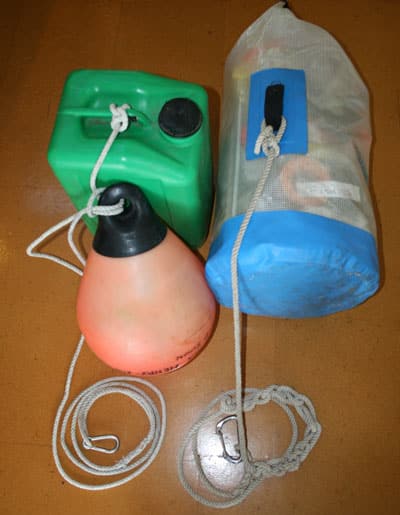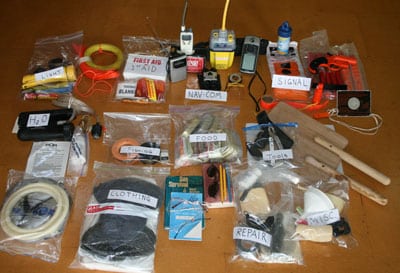
Ditch bag
When they’re faced with an ever-expanding list of work and expensive equipment required for departure into the briny blue, it’s understandably difficult for potential cruisers to divert time and money toward an event as unlikely as abandoning ship. And after all, no matter how extreme the conditions, abandoning the boat is a tactic of last resort: Consider how often we’re told that one should only step up into a life raft.
But if and when you ever do, you’ll find that the quantity and quality of survival equipment packed inside the average life raft is laughable—laughable, that is, if the situation weren’t potentially a matter of life and death for yourself and your family or crew.
Fortunately, technology has come a long way, and we now have more affordable and efficient emergency signaling devices and more sophisticated search-and-rescue facilities. But just as the bottom of our charts always cautions that the prudent mariner will not rely solely on any single aid to navigation, neither should the prudent mariner rely on a single piece of equipment, such as your EPIRB. While rapid rescue is clearly preferable, survival is the primary goal, and the likelihood of that happy outcome is immensely enhanced with thoughtful planning.
As a way to prepare, I find it helpful to visualize the conditions that might lead to abandoning ship, then mentally walk myself through the evacuation procedures. I break down the ensuing events and activities into cohesive, thematic segments, including stabilizing the raft and occupants, activating rescue procedures, employing survival equipment and techniques, navigation, and the eventual pickup or landing, always remembering that landing itself may not mean the immediate end of the ordeal.
Fire is a leading cause of sinking, so give careful thought to the accessibility of the overboard bag. Next, the bag must be manageable in size, shape, and weight. Make sure that you don’t overlook the attachment system, for all your hopes will float away with your bag if the tether fails. Personally, I don’t want lives to depend on a knot tied in a panic, so I use a large carabiner to attach the bag to the boat, and then to the life raft.
There are several reasons that I use a heavy-duty dry bag as my overboard container. First, because if I leave as much air inside as possible, it floats. Still, I add secondary flotation in the form of an attached marker buoy and a jerry jug filled only two-thirds full with potable water. That jerry jug along with rain-catching tarps and a handheld watermaker may prove a godsend in the days, if not weeks, to come. Another important feature is that the bag is absolutely waterproof, thus protecting the vital equipment and supplies inside. Nevertheless, all the supplies are also bagged separately inside, which helps with organization as well. In addition, the dry bag has no hard edges, which is seemingly a small thing until your life raft is tossed about in mountainous seas.

| | By categorizing the ditch-kit contents and bagging each group separately, the ditch kit can be packed in order of anticipated need to limit rummaging through the bag during an abandon-ship situation. When planning your ditch kit, remember that you’d rather have an item and not need it than not have it and need it.|
Inside the bag I layer the equipment, all well labeled, in the anticipated order of urgency. On top are the headlamps, flashlights, and chemical light sticks. Next is a throwing line to assist exhausted swimmers in reaching the raft. Then comes a first-aid kit to deal with likely injuries suffered from the catastrophe. Since getting and staying warm is critical even in tropical seas, Mylar emergency blankets and heat packs come next. Only when the entire crew is on board, stabilized, and dosed with seasickness pills to prevent dehydration will the EPIRB, VHF (with expedition-style portable battery), GPS, flares, smoke flare, dye marker, and strobe come out of the bag.
I continue my visualization: Once I activate the EPIRB, I then establish our exact position with the waterproof GPS and instigate backup Mayday calls via the handheld VHF at regular intervals. After our situation has stabilized, I discuss with the crew in a positive yet truthful manner the challenges we face; I’m careful not to promise or rely on immediate rescue. We take stock of the equipment at hand and discuss the tactics to be used. We also establish watches, allocate responsibilities, and immediately implement a rationing system, especially for the fresh water.
Space doesn’t allow a detailed breakdown of every item I include in the overboard bag that my wife, Diana, and I keep on board our 36-foot steel cutter, Roger Henry, but my overall approach is that I’d rather have it and not need it than need it and not have it. That said, all survival literature indicates that the single most important ingredient for success is the crew’s morale. Be creative in your planning. Stash an unexpected treat or two in the bag. A small shortwave radio receiver can be a source of news, weather, and entertainment. I keep an unabridged copy of War and Peace in the ditch kit, which I plan to read out loud to my crew at a rate of perhaps 20 pages a day. My theory is that no one, however weakened or discouraged, could even consider giving up the ghost until he or she finds out what happens to Natasha and Pierre.
The Five Kinds of Gear in Alvah Simon’s Ditch Bag
For Initial Stabilization
• Heavy-duty dry bag, with strong lanyard, carabiner, and marker/float
• Jerry jug with tether for water
• Throwing line
• Flashlights/headlamp/chemical light sticks
• First-aid kit
• Mylar emergency blanket
• Chemical heat packs
• Air pump
• Raft repair kit (patches, plugs, glue)
• Sponge/bailer
For Rescue
• EPIRB (registered)
• GPS (waterproof)
• VHF (waterproof), with additional battery
• Flares, smoke flares, dye markers, reflectors
• Distress flag
• Signaling mirror
• Whistles/horn
• Reflective tape and flagpole
• Binoculars
For Survival
• Survival manual
• Watermaker
• Rain tarps
• Funnel, hose, containers
• Resealable bags
• Food supply (pemmican, survival biscuits, canned fish, glucose tabs)
• Medical kit (including your prescription medications)
• Fishing kit
• Repair kit (duct tape, wire, rope, string)
• Spare batteries
• Goggles
• Knives/multitool/sharpening stone
• Work board
• Hats, gloves, sunglasses, sunscreen, shirts
• Sewing kit
• Camping towel
• Clothespins
• Reading glasses
• Reading material
• AM/FM radio or small shortwave-radio receiver
For Navigation
• Maps and wind and current charts
• Compass
• Paddles
• Watch
• Paper and pencils
For Landing
• Document bag
• Footwear
• Lighter/fuel stick
• Currency
Circumnavigator and high-latitude sailor Alvah Simon is a 2013 Cruising World Boat of the Year judge.








